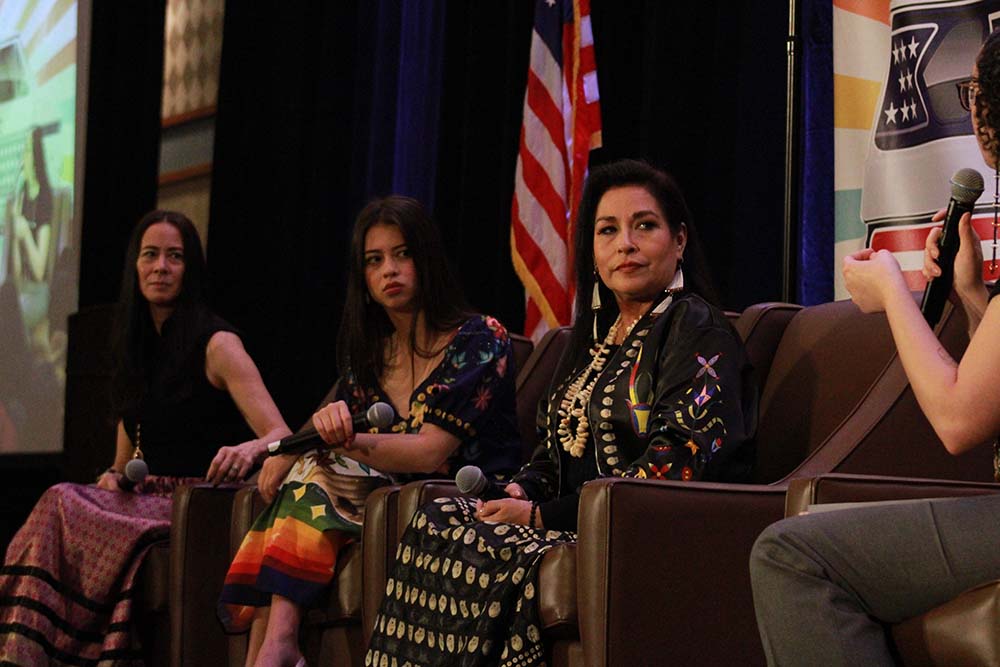
- Details
- By Darren Thompson
Science-fiction film Prey, produced by Jhane Myers (Comanche Nation of Oklahoma) has been nominated for six Emmy Awards including Outstanding Television Movie.
Myers told Native News Online that she was surprised to hear the number of nominations the film earned.
“I was beyond surprised,” Myers said. “Six nominations—that’s pretty incredible.”
Myers said she didn't sleep much last Tuesday night, as she was anticipating the Television Academy to announce finalists for the 75th Emmy Awards. That night, she was visited in her dreams by her Blackfeet grandmother.
 Make A Monthly Donation Here
Make A Monthly Donation Here
“I don't always dream of my relatives,” Meyers said. “She was really gorgeous and young, and smiling at me. I guess my grandmother knew the results before me. This year has been a banner year for representation and recognition for Native people.”
Prey is the prequel and fifth film in the Predator series, and the first feature film to have a Comanche language version.
Along with Outstanding Television Movie, Prey earned nominations in Outstanding Directing for a Limited or Anthology Series or Movie; Outstanding Picture Editing For a Limited or Anthology Series or Movie; Outstanding Music Composition For a Limited or Anthology Series, Movie, or Special (Original Dramatic Score); Outstanding Television Movie; Outstanding Sound Editing for a Limited or Anthology Series, Movie, or Special; and Outstanding Writing For a Limited or Anthology Series or Movie.
The film’s release skipped theaters and premiered on streaming-service Hulu on August 5, 2022. Disney, owner of Hulu, told the Hollywood Reporter that Prey was Hulu’s top premier in the streamer’s history within the first week of the film’s release.
Since the film was released last summer, it has earned numerous awards, nominations and recognitions, including Best Streamed or Television Movie by the Producers Guild of America Awards. Prey has been acknowledged by numerous other organizations for its authenticity to Comanche culture and French culture.
Myers said of the film’s success, “the little movie that keeps on going and going.”
The film’s story is set in the Northern Plains in the early 1700s, and features Amber Midthunder, who’s Nakota and enrolled in the Fort Peck Assiniboine and Sioux Tribe in Montana. Myers oversaw the film’s attention to detail of authentic Comanche culture and language.
One of the aspects of the script Myers said she was able to change to reflect Comanche culture was adding horses to the story. Prior to Myers joining the production, the script included the Comanche, but not horses, which are central to Comanche culture. By the 1700s the Comanche were already living a fully nomadic lifestyle after acquiring horses from other Southwestern Tribes.
Earlier this year, Myers was nominated by the Producers Guild of America for her work in Prey. She was a finalist in the “Award for Outstanding Producer of Televised or Streamed Motion Pictures” category.
Award-winning Taos Pueblo musician Robert Mirabal contributed Native American flute and vocals to the film’s score, which was composed by Sarah Schachner. Mirabal was invited to contribute to the score after Myers introduced him to Schachner.
According to the Television Academy, there are more than 20,000 voting members of the Academy and this year’s nominations marked the highest voter participation in Emmy history. Membership in the Academy is open to working professionals in the television industry.
The 75th Emmy Awards is currently scheduled to broadcast live on FOX on Monday, September 18, (8:00-11:00 PM EDT/5:00-8:00 PM PDT) from the Peacock Theater at L.A. LIVE.
More Stories Like This
Chickasaw Holiday Art Market Returns to Sulphur on Dec. 6Center for Native Futures Hosts Third Mound Summit on Contemporary Native Arts
Filmmakers Defend ‘You’re No Indian’ After Demand to Halt Screenings
A Native American Heritage Month Playlist You Can Listen to All Year Long
11 Native Actors You Should Know
Help us defend tribal sovereignty.
At Native News Online, our mission is rooted in telling the stories that strengthen sovereignty and uplift Indigenous voices — not just at year’s end, but every single day.
Because of your generosity last year, we were able to keep our reporters on the ground in tribal communities, at national gatherings and in the halls of Congress — covering the issues that matter most to Indian Country: sovereignty, culture, education, health and economic opportunity.
That support sustained us through a tough year in 2025. Now, as we look to the year ahead, we need your help right now to ensure warrior journalism remains strong — reporting that defends tribal sovereignty, amplifies Native truth, and holds power accountable.
 The stakes couldn't be higher. Your support keeps Native voices heard, Native stories told and Native sovereignty defended.
The stakes couldn't be higher. Your support keeps Native voices heard, Native stories told and Native sovereignty defended.
Stand with Warrior Journalism today.
Levi Rickert (Potawatomi), Editor & Publisher
